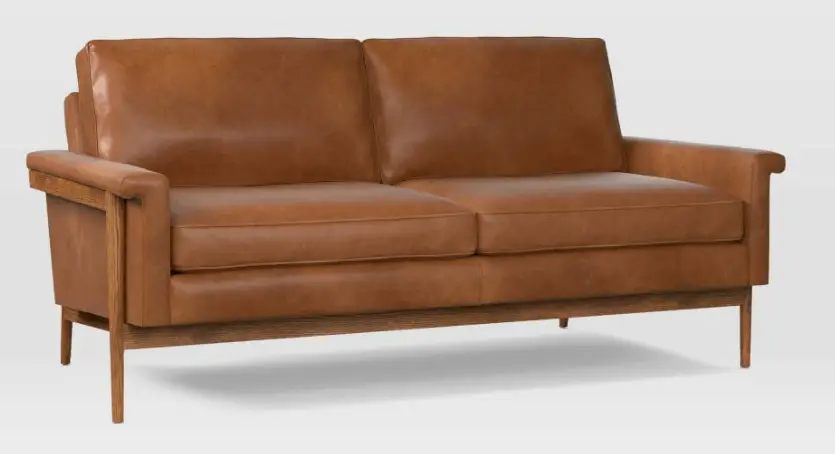One of the most common questions I get from readers has to do with 'Vegan Leather', and how it compares to typical full-grain or top grain leathers. Many are interested in leather alternatives due to concerns regarding the potential harm of cows in the production of leather.
But does it make sense to buy a sofa made of vegan leather?
Vegan leather sofas are made from synthetic materials and don't hold up as well as traditional leather sofas. However, some budget based consumers or those looking for an animal-friendly leather might find a vegan leather sofa to be a good alternative.
Let's take a closer look at how vegan leather couches are made and whether or not they should be considered when purchasing a new sofa.
What Is Vegan Leather And How Does It Differ From Regular Leather?
Vegan leather, which is often called 'faux-leather' is an artificial leather that is meant to mimic real leather. Faux leathers early on were made from PVC, however environmental concerns have led to more usage of polyurethane in recent years.
Polyurethane (sometimes referred to as PU leather in the furniture industry) is a man-made material that has been around since the 1940s and first got its use as replacement for rubber during World War II.
In more recent years, however, people have found other uses for this versatile material such as upholstery filling, flooring underlayment, and shoe soles.
If you are looking to really get into the chemistry of it this is a pretty good video explainer of how polyurethane is made.
There are many companies that provide vegan or 'faux' leather and there are many different ways that it is produced. Thus, the method of production can dictate the overall impact on the environment.
The more common approach to creating a 'faux' or vegan leather sofa involves using a plastic polyurethane mixture and applying it to a leather like paper which has a similar texture to real leather.
This plastic coated paper is heated and then an additional thickening foam is added to provide more structure. An additional backing is added and then the paper is removed to reveal the end product.
Vegan leather can be used anywhere you would traditionally use regular leather, such as furniture upholstery or car seats because it has similar properties like durability, flexibility, softness and wear resistance.
Now the major differences between a vegan leather and a real leather is the fact that leather is a natural material, made from the hide of a cow, while faux leather is made from plastics. As for leather couches, most of the best quality leathers are made from the hides of steer (a male cow), with the leather commonly known as 'steerhide'.
Like faux leathers, real leathers are used for many different products, including car interiors, shoes and clothing. However, the costs for a real leather are significantly higher than any vegan or faux leathers.
Why Do Some People Choose Vegan Leather For Furniture?
There are a number of reasons why people choose vegan leather for furniture. One reason is that it's more environmentally friendly than traditional leather, which typically comes from cows raised in confined animal feeding operations (CAFOs).
There are also health concerns with the use of real leather, as CAFOs produce toxic fumes and diseases that can be passed to humans through contact with animal skin or hair.
Finally, some people prefer vegan leather because they don't want animals to suffer any harm. If you're looking for an eco-friendly material for your next piece of furniture, then you might consider getting something made from vegan leather!
I should note that there are some leather such as Bicast leather that use a genuine leather base with a polyurethane coating, thus if your goal is to avoid any animal based product, Bicast leather would not be an appropriate choice.
Are Vegan Leather Sofas Easier To Maintain?
A vegan leather sofa will be easier to clean and maintain than a traditional leather sofa. Vegan leather doesn't absorb water, thus, it is naturally waterproof because of the materials used.

This is in contrast to a real leather sofa, which will typically absorb any liquid. Some leathers can better protect although some leathers that aren't finished will show a stain on the surface of the couch.
Cleaning a vegan leather sofa is fairly simple and a damp cloth can be used to provide a light cleaning. This is in contrast to a traditional leather sofa which requires a bit more maintenance and more expensive cleaning products.
How Can I Tell The Difference Between A Vegan And A Real Leather Couch?
It's not always easy to tell the difference between real and fake leather - you can usually spot the difference by looking at the texture of the material.
Faux or vegan leather will generally have a slightly different texture than real leather and will feel less supple. Today's vegan leather is made so well, that sometimes it can be hard to distinguish versus the real thing.
One way to typically tell is by smelling the surface of the furniture. A leather smell on a sofa is quite distinguishable, and very different in comparison to a vegan leather, which as a chemical like smell, which can sometimes fade over time thankfully. However, some manufacturers try to mask the smell, even using artificial leather smells to mask the odors.
The imperfections on what real leather are what many consumers cherish about a real leather sofa. The hide from the cow tells the true story. This isn't the case on a lot of newer synthetic leathers, but of course, the manufacturers have gotten so good, that the patterns used can often mimic that of a real hide.
So, ultimately, the only fool-proof way is by getting the information from the manufacturer--as the following video recommends.
How Much Does A Vegan Leather Sofa Cost?
The cost of faux-leather furniture varies depending on where you buy it, however, most stores sell them for less money than their real counterparts.
Typically most vegan leather sofas will cost less than $2000.
I did a search at IKEA and found the Finalla sofa which is $1199
It's a nice looking couch, but you can almost tell from the photo that it isn't real leather. I then looked at the description and found that the sofa was made with the following materials:
Dyed through top-grain leather with a treated, embossed and pigmented surface
Now, this wouldn't be the best option for someone that wants an animal-free leather, since it is using a base of a top-grain leather, which is then treated with polyurethane.
Here's one from West Elm for $1999, which in my mind is a great looking sofa.

A West Elm Vegan Leather Sofa, which gets good reviews from customers
Now, West Elm uses what they call "animal-friendly vegan leather." The description says:
"Our Vegan Leather is an animal-friendly faux leather that's made of 100% nylon and has a soft, smooth handfeel that mimics real leather. A polyurethane topcoat makes it more durable, however, maintaining its coloring and surface appearance."
This is the sort of sofa I would recommend if you are interested in an animal-friendly faux leather.
How Long Will A Faux or Vegan Leather Sofa Last?
I decided to outsource this question and called over to one of my local furniture stores, that deals exclusively in higher end leather sofas such as Bradington Young and Hancock & Moore. The salesperson I spoke to -- (I'll call her Emma), was really knowledgeable about her stuff, but I know that they are going to be biased since they basically compete against any lower priced furniture retailers that sell fake leather couches.
She told me that a vegan or faux leather sofa can be a good option for anyone that can't afford a high quality leather sofa, because the durability of the faux leather coach is going to pale in comparison to a real leather sofa which can last at a minimum between 15 to 20 years.
Vegan or faux leather has a tendency to peel and crack--"just think of how it's made!" she told me, and she brought up a good point and yes, if you consider how the plastic is added to the base, it does make a lot of sense. Some higher quality faux leathers might make it 5+ years she said, but if you are going to spend $2000 or more, don't even think about buying a faux leather couch.
Have you had a good or bad experience with a vegan or faux leather sofa?
Let us know in the comments below!



Thanks for this, was considering the purchase of a faux leather and this helped me when going to purchase a new sofa
Thanks for writing this. Been looking to get a couch for the family and just didn’t know which to get the traditional leather or vegan. It’s kind of a big purchase (for me at least). Thanks for breaking it down